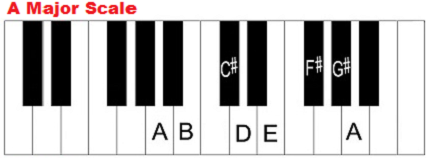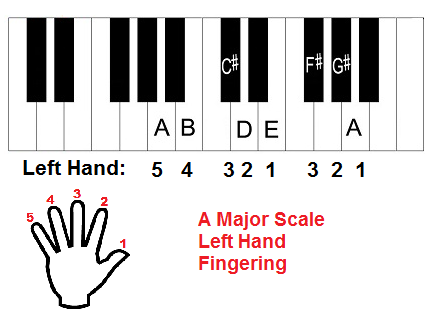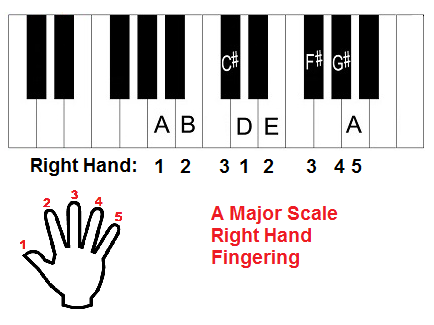In this lesson we will take a look at the A major scale.
First of all, the notes of this scale are A – B – C# – D – E – F# – G# – A. The note, A repeats one octave higher. Its key signature has three sharps.
Intervals
- Tonic: A
- Major 2nd: B
- Major 3rd: C#
- Perfect 4th: D
- Perfect 5th: E
- Major 6th: F#
- Major 7th: G#
- Perfect 8th: A

My #1 Recommendation: Go here to learn about the BEST piano/keyboard course I’ve seen online.
Scale Degrees
- Tonic: A
- Supertonic: B
- Mediant: C#
- Subdominant: D
- Dominant: E
- Submediant: F#
- Leading tone: G#
- Octave: A
A Major Scale on Treble Clef 
Bass Clef 
Video:
Formula
The major scale formula is W-W-H-W-W-W-H. This stands for whole step, whole step, half step, whole step, whole step, half step. You can for any major scale using this formula. Half steps and whole steps are the distance from one key to another. A half step is the distance from one key to the key that is closest to it. For instance C# to D is a half step. G# to A is also a half step. A whole step skips a key. Two half steps make up a whole step. For instance, A to B is a whole step. B to C# is a whole step as well.
Using the formula, W-W-H-W-W-W-H, starting on A, move one whole step to B, a whole step to C#, a half step to D, a whole step to E, a whole step to F#, a whole step to G# and a half step to A.
Fingering of A Major Scale
What’s the fingering for this scale? It’s as follows:
- Notes: A, B, C#, D, E, F#, G#, A
- Fingerings (Left Hand): 5, 4, 3, 2, 1, 3, 2, 1
- Fingerings (Right Hand): 1, 2, 3, 1, 2, 3, 4, 5
(Thumb is finger 1, index finger is finger 2, middle finger is 3, ring finger is 4 and pinky finger is 5.) 

Video: How To Play The A Major Scale On Piano and Keyboard
What are the triad chords in the key of A? They are as follows:
- Chord I: A major. Its notes are A – C# – E.
- Chord ii: B minor. Its notes are B – D F#.
- Chord iii: C# minor. Its notes are C# – E – G#.
- Chord IV: D major. Its notes are D – F# – A.
- Chord V: E major. It’s notes are E – G# – B.
- Chord vi: F# minor. Its notes are F# – A – C#.
- Chord vii: G# diminished. Its notes are G# – B – D.
Diatonic Triads In A major: A – Bm – C#m – D – E – F#m – G#dim
Video: Chords In The Key of A Major
Here’s a video showing the chords in the key of A based on the A major scale.
Go here to learn more about chords in the key of A major.
The relative minor for A major is F sharp minor. The relative minor of a major key is based on the 6th note of the major scale. Major scales and their relative minor scales have the same notes except that they start on a different note. The notes of the F# minor scale are F# – G# – A – B – C# – D – E – F#.
Modes of the A major scale:
- Ionian/Major Scale: A – B – C# – D – E – F# – G# – A
- Dorian: B – C# – D – E – F# – G# – A – B
- Phrygian: C# – D – E – F# – G# – A – B – C#
- Lydian: D – E – F# – G# – A – B – C# – D
- Mixolydian: E – F# – G# – A – B – C# – D – E
- Aeolian/Natural minor scale: F# – G# – A – B – C# – D – E – F#
- Locrian: G# – A – B – C# – D – E – F# – G#
Major and Minor Scales in All Keys
How To Form Major, Minor, Chromatic, Pentatonic, Blues, Whole Tone Scales & More
Piano Keyboard Lessons Home Page